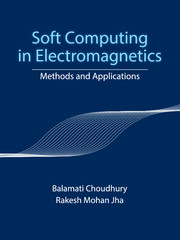Book contents
- Frontmatter
- Dedication
- Contents
- List of Figures
- List of Tables
- Preface
- Acknowledgments
- Abbreviations
- Symbols
- 1 Introduction
- 2 Soft Computing Techniques
- 3 Soft Computing in Electromagnetics: A Review
- 4 Bacterial Foraging Optimization For Metamaterial Antennas
- 5 PSO for Radar Absorbers
- 6 Characterization of Planar Transmission Lines Using ANN
- 7 Fault Detection in Antenna Arrays
- 8 Multi-Objective Particle Swarm Optimization for Active Terahertz Devices
- 9 Soft Computing based CAD Packages for EM Applications
- Author Index
- Subject Index
- References
4 - Bacterial Foraging Optimization For Metamaterial Antennas
Published online by Cambridge University Press: 05 July 2016
- Frontmatter
- Dedication
- Contents
- List of Figures
- List of Tables
- Preface
- Acknowledgments
- Abbreviations
- Symbols
- 1 Introduction
- 2 Soft Computing Techniques
- 3 Soft Computing in Electromagnetics: A Review
- 4 Bacterial Foraging Optimization For Metamaterial Antennas
- 5 PSO for Radar Absorbers
- 6 Characterization of Planar Transmission Lines Using ANN
- 7 Fault Detection in Antenna Arrays
- 8 Multi-Objective Particle Swarm Optimization for Active Terahertz Devices
- 9 Soft Computing based CAD Packages for EM Applications
- Author Index
- Subject Index
- References
Summary
The increasing demand for wireless capabilities in modern systems has ushered in the development of compact, high performance antennas. Typically, engineers involved in the design of systems for aerospace applications prefer the use of microstrip, conformal antennas for reduction of drag. However, traditional microstrip antennas have low performance characteristics. Research has shown that the inclusion of metamaterial layers in antenna design can significantly improve its performance. Therefore, the design of metamaterial resonating at the same frequency as the antenna under consideration is crucial to the development of high performance antenna systems. This in fact becomes a time consuming procedure as it requires a systematic variation of structural parameters of the metamaterial while simultaneously observing its performance. In this chapter, an attempt has been made to optimize the procedure for metamaterial design by using bacterial foraging optimization (BFO). This soft computing technique will reduce the time taken for obtaining optimized structural parameters and enable rapid design of high performance antenna systems.
Overview
The usage of a metamaterial layer in an antenna results in a system that shows higher performance—gain enhancement and multi-band operation, and better capability of compact design by reduction of mutual coupling, in the case of antenna arrays. This has led to the application of such systems in wireless communications, especially in the aerospace domain [Lafmajani and Rezaei, 2011]. These systems are often realized by loading a microstrip antenna with a metamaterial as shown in Fig. 4.1.
As mentioned earlier, the performance of such systems depends on the design of the metamaterial—best performance is observed when the resonant frequency of the metamaterial matches with that of the antenna. Achieving this design objective is a time-consuming task that requires simulation by changing structural parameters iteratively. Efforts are being made to decrease the time involved in obtaining optimized structural parameters using various soft computing techniques such as genetic algorithm, particle swarm optimization, etc.
Genetic algorithm (GA) was used by Kim and Yeo [Kim and Yeo, 2007] to design an AMC (artificial magnetic conductor) for a dual band, passive RFID tag antenna. The algorithm was used to optimize the lumped circuit elements in the equivalent circuit of the AMC. The resultant antenna resonated in the 869.5–869.7 MHz and 910–914 MHz bands, thereby conforming to European and Korean UHF standards, respectively.
- Type
- Chapter
- Information
- Soft Computing in ElectromagneticsMethods and Applications, pp. 65 - 83Publisher: Cambridge University PressPrint publication year: 2016



